Ohio State University
 From Nwe
From Nwe 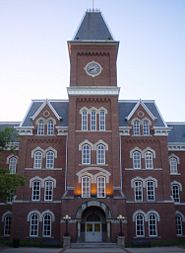
|
|
| Motto | Disciplina in civitatem (Latin) Education for Citizenship |
|---|---|
| Established | 1870 |
| Type | Flagship Public Land grant Sea grant |
| Location | Columbus, Ohio United States |
| Website | www.osu.edu |
The Ohio State University (OSU) is a public research university in the state of Ohio. It was founded in 1870 as a land-grant university comprising a technology and agricultural school. It has grown into a large university offering liberal arts and science degrees as well as numerous research institutions, and facilities across the United States, as well as several satellite campuses throughout the state. Since the last half of the twentieth century, Ohio State University has become a nationally and internationally respected school, with one of the largest student populations in the United States.
The mission of OSU is to improve the quality of life of people both locally and worldwide, and it aims to do this through the discovery and communication of knowledge. This goal is a noble one, and those at OSU have striven hard to advance knowledge in all fields related to human endeavor. Their success is evident in the achievements of OSU alumni. OSU also strives to include a wide diversity of students, offering educational opportunities to students of varying backgrounds, and thus provides an environment rich in experience and possibilities beyond academic education. Improving the quality of human life takes more than academic knowledge and technical mastery. To accomplish this, areas of human life that go beyond intellectual and practical development, entering the realms of human character, relationships, and spirituality, are also important.
Mission and reputation
Ohio State University (OSU) states its mission statement as simply, "To advance the well-being of the people of Ohio and the global community through the creation and dissemination of knowledge."[1] In order to achieve this goal, the University states that it places emphasis upon the pursuit of knowledge and research, community service, global outreach, and diversity within its student body.[1]
OSU has a long standing reputation in excellence. In 2007, the Lombardi Program on Measuring University Performance at Arizona State University detailed analysis and rankings of American universities placed Ohio State as the 24th ranked university in America, the 10th ranked public university in America and the top overall university in Ohio. Of their nine ranking criteria, Ohio State ranked in the top 25 in four categories and between 26-50 in an additional four categories.[2] The Washington Monthly college rankings which seek to evaluate colleges' contributions to American society based on factors of social mobility, cutting edge research, and service to the country by their graduates currently places Ohio State as 12th in the nation and tenth among public universities.[3] In its 2009 ranking of best schools in America, the U.S. News & World Report placed Ohio State as the nineteenth best public university and 56th overall ranked university in America as well as the highest ranked public university in Ohio.[4] Ohio State ranked 14th in US News' New "Up and Coming" colleges section.
With over 50,000 students at its Columbus campus alone, OSU consistently has one of the largest university student populations in the United States.[5] This student body is diverse, and deliberately so: "We believe college can be a reality for everyone, no matter your income or background. It's a matter of finding good information, the right people to help and planning wisely."[6]
History
Ohio State University was founded in 1870 as a land-grant university in accordance with the Morrill Act of 1862 under the name of The Ohio Agricultural and Mechanical College. Initially, it was thought that one of Ohio's two existing public universities (Ohio University and Miami University) would be designated as the land-grant institution, and each engaged in a vigorous competition to win over the state legislature. At the strong urging of Governor Rutherford B. Hayes, however, it was ultimately decided to establish a new university to be located near the legislature in Columbus. Hayes' role in founding the university is recognized in Hayes Hall, the oldest building still standing on the campus. Hayes later noted that the founding of Ohio State was one his two greatest achievements—the other being Ohio's ratification of the Fifteenth Amendment.[7]
The school was originally situated within a farming community located on the northern edge of Columbus, and was intended to matriculate students of various agricultural and mechanical disciplines. From its inception, a debate was waged between those in favor of broadening the university's focus to encompass the liberal arts and sciences and those who favored a more limited focus. Governor Hayes viewed the selection of the university's location as key to keeping the university free of excess influence by the state's agricultural interests. As such, he worked strongly behind the scenes to ensure that the campus would be located in the city of Columbus rather than the more agriculturally oriented towns of Springfield or Urbana. The campus' location near the state capital combined with Hayes' plan of an expanded board of trustees based upon one member from each of the state's congressional districts ensured that his vision for the new university's curriculum would be put into place. Subsequently, the new board of trustees decided to offer seven fields of study: agriculture, ancient languages, chemistry, geology, mathematics, modern languages, and physics. Later that year, the university welcomed its first class of twenty-four students, including three women. In 1878, and in light of its expanded focus, the college permanently changed its name to the now-familiar "The Ohio State University."
Two factors in Ohio State's formative years would hinder the university's immediate development: Hostility from the state's agricultural interests and competition for resources from Miami University and Ohio University. The first arose from the curriculum debate. Fueled by the agriculture interests and the Springfield business community that supplied them, the attitude of Ohio farmers towards the university had turned from one of indifference to one of outright hostility. By 1880, this hostility had begun to make its presence felt in the state legislature. The second hindrance came in the form of competition for state allocations from Ohio's two older public institutions. At the time of Ohio State's creation, these institutions had been derided by then Governor Hayes as borderline sectarian colleges that, in over sixty years of history, had failed to provide Ohio with a real state university. It was this view that was fundamental in the decision to found a new university as recipient for the Morrill Act funds, making Ohio unique among Great Lakes states in founding a new university for this purpose, as well as considerably strengthening the hand of those who advocated a broad based curriculum. However, the founding of this new university combined with their own precarious financial positions (Miami would close for a dozen years due to a lack of enrollment) had awakened the older institutions to compete vigorously for the attention of the state legislature. The first of these issues would be resolved by the end of the decade. Resolution of the second would not occur until 1906. Even then, the inherent tension of agricultural interests within the larger context of a comprehensive research university and the competition among state universities in a decentralized higher education system would, to varying degrees, remain permanent issues with which Ohio State would be forced to contend.
Of fundamental importance in this period was the role of former President Rutherford B. Hayes who, a decade earlier, had lobbied strenuously as Governor for the university's founding. Upon returning to Ohio in 1881, the former President spent the next decade using his considerable political influence to lobby for the university's interests. In 1887, he formally joined the university's board of trustees where, until his death in late 1891, he essentially acted as the university's de facto president. By 1891, Ohio State had grown to a degree that Governor James E. Campbell recommended a permanent levy on the tax duplicate to support its continued growth. The significant role that the fledgling university had begun to play within the state, as well as the peace that Hayes had brokered with the state's agricultural interests, was underscored by the fact that the proposal passed without opposition despite the insistence of Ohio State's board of trustees that neither Miami nor Ohio universities be included in the bill.[8]
Emergence as Ohio's flagship university (1892-1916)

Ohio State began accepting graduate students in the 1880s, with the university awarding its first master's and doctoral degrees in 1886 and 1890 respectively. 1891 saw the founding of Ohio State's law school.
In 1906, Ohio State President William Oxley Thompson along with the university's supporters in the state legislature put forth the Lybarger Bill with the aim of shifting virtually all higher education support to the continued development of Ohio State while funding only the "normal school" functions of Miami and Ohio University. Although the Lybarger Bill failed narrowly to gain passage, in its place was passed the compromise Eagleson Bill, which determined that all doctoral education and research functions would be the role of Ohio State and that the two older institutions would not offer instruction beyond the master's degree level. This arrangement would stand for the next fifty years until population growth had necessitated additional Ph. D programs in the state.
1912 saw the formation of Ohio State's Graduate School to coordinate the university's burgeoning master's and doctoral enrollments. In 1914, Ohio State's college of medicine was formed through a merger with Starling Medical College. That year also saw the founding of Ohio State's School of Dentistry. In 1916, the board of trustees approved the formation of a College of Commerce and Journalism.
Subsequently, Ohio State's solidifying of its role as the state's flagship, comprehensive university was fairly rapid, as demonstrated by its 1916 induction into the prestigious Association of American Universities.
Growth and challenge (1917-1945)
This momentum was further accelerated by Governor Harry L. Davis, who in his 1921 inaugural address declared:
In Ohio State University the commonwealth has an educational institution which should become the largest and best state institution in the United States. This is evidenced by the development of the institution in recent years, and I desire specifically to ask the co-operation of the General Assembly in the effort which I propose to make to help the Ohio State University to attain that goal in the not too distant future.
He subsequently shepherded a one-eighth of a mill tax levy through the legislature to fund a university building fund. Seventy-two percent of the funds were earmarked for the Ohio State University with the remainder split between Miami University and Ohio University.[9] By 1930, the university's enrollment stood at 15,126, a more than fourfold increase from just twenty years prior.
With the onset of the Great Depression, Ohio State faced many of the challenges affecting universities throughout America as budget support was slashed, and students without the means of paying tuition returned home to support families. By the middle thirties, however, enrollment had stabilized due in large part to the role of FERA (the Federal Emergency Relief Administration) and later the NYA (National Youth Administration).[10] By the end of the decade, enrollment had still managed to grow to 17,568. Two important initiatives begun during this decade came to play increasingly important roles in the university's development. In 1934, the Ohio State Research Foundation was begun to bring in outside funding for faculty research projects. In 1938, a development office was opened to begin raising funds privately to offset reductions in state support.
Making a name for itself (1946-present)
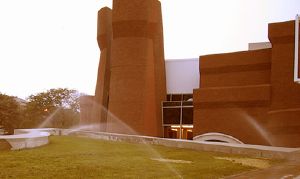
Expansion of the university continued exponentially throughout the twentieth century. Between 1957 and 1971, four satellite campuses (Marion, Newark, Mansfield and Lima) were opened, all specialty schools designated to teach in areas of technology and agriculture. The scope and prestige of Ohio State University continued throughout the latter part of the twentieth century, particularly when it was among the first group of public universities to raise a billion dollar endowment when it passed the one billion dollar mark in 1999. At year’s end 2005, Ohio State’s endowment stood at 1.73 billion dollars ranking it seventh among public universities and twenty-seventh among all American universities.[11] In June 2006, the endowment passed the 2 billion dollar mark.
Facilities
Ohio State's main urban campus, located in Columbus, is over 1,700 acres in size, and offers large green areas as well as the feel and cosmopolitan atmosphere of a metropolitan area. The Oval, one of the largest open areas on campus, located in the center of university's most developed areas is popular with students in the warmer months of the school year. This 11 acre site is often the location for large outdoor gatherings, concerts, demonstrations, and various sporting events.
The sheer physical size of the campus, along with its large student population, means that there are numerous facilities for students and faculty alike. At the eastern end of the Oval, is the Wexner Center for the Arts. Designed by architects Peter Eisenman of New York and Richard Trott of Columbus, the center opened in 1989. Its founding was financed in large part by Ohio State alumnus Leslie Wexner with a gift of twenty-five million dollars in the 1980s. The center was founded to be a comprehensive visual arts center encompassing all aspects of visual and performing arts with a focus on new commissions and artist residencies. The centerpiece of The Wexner Center's permanent collection is Picasso's Nude on a Black Armchair.[12] OSU has several other museums on campus, including the Frank W. Hale Jr. Black Cultural Center, Historic Costume and Textiles Collection, Jack Nicklaus Museum, and Orton Geological Museum. The university also hosts a 60 acre arboretum named after Ohio State Horticulture professor Dr. Lewis C. Chadwick.[13]
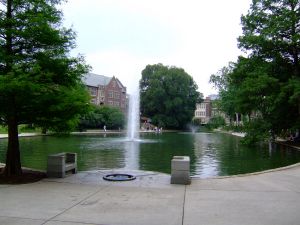
Overall, Ohio State operates the 18th largest university research library in North America with a combined collection of over 5.8 million volumes. Additionally, the libraries receive approximately 35,000 serial titles on a regular basis. Ohio State's library system encompasses twenty-one libraries located on its Columbus campus.[14] An additional eight branches are located at off-campus research facilities, regional campuses, and a book storage depository near campus. In all the Ohio State library system encompasses fifty-five branches and specialty collections. Some of the more significant collections include the Byrd Polar Research Center Archival Program containing the Archives of Admiral Richard E. Byrd as well as a significant collection of polar research materials, the Hilandar Research Library which contains the world's largest collection of medieval Slavic manuscripts on microform, The Ohio State Cartoon Research Library, which is the world's largest repository of original cartoons, the Lawrence and Lee Theatre Research Institute, and the archives of Senator John Glenn.
OSU has many athletic facilities to host not only its many sports teams, but also for student wellness and fitness. Among 17 athletic arenas, Ohio Stadium is perhaps the best known. Home of the Buckeyes football team, the stadium is one of the largest college football stadiums in the U.S.[15] OSU has also has other facilities for training and performance in basketball, hockey, soccer, crew, golf and other sports. OSU has two main student physical activity centers: The Recreational Adventure Center and Recreational and Physical Activity Center. Additionally, there is also the Student Wellness Center devoted to promoting healthy lifetstyles for OSU students and faculty.

The Ohio State College of Medicine is located on the southern edge of the central campus. It is home to the James Cancer Hospital, a cancer research institute and one of the National Cancer Institutes thirty-nine comprehensive cancer centers, along with the Richard M. Ross Heart Hospital, a research institute for cardiovascular disease.
Ohio State operates 31 on-campus residence halls divided into three geographic clusters: South Campus (site of the university's original dormitories), North Campus (largely constructed during the post-war enrollment boom), and Olentangy Area or "The Towers." Within the residence hall system are 40 smaller living and learning environments defined by social or academic considerations. Ohio State also offers four honors residence halls: Bradley Hall, Lincoln House, Siebert Hall, and Taylor Tower.
Separate housing for graduate and professional students is maintained on the Southern tier of campus near the medical complex. Family housing is maintained at Buckeye Village at the far northern edge of campus beyond the athletic complex. At the university's southeast corner along High Street, and across from the Moritz College of Law, apartments have been built for law students in conjunction with the area's Campus Gateway project.
Programs

OSU offers over 100 different programs, ranging from a selection of liberal arts and sciences undergraduate degrees, to masters and doctorate level degrees, as well as numerous medical and advanced training degrees. Many of OSU's programs are well respected and highly ranked. Of particular acclaim are the Business, Education, Political Science, numerous Art programs (both fine and Performing arts), Architecture, Engineering and many science programs at the undergraduate and graduate level.
Ohio State offers two distinct honors programs for high ability undergraduates: Honors and Scholars. The Honors program is open to students in all majors. The Scholars program is centered around thirteen specific programs such as "Architecture Scholars," "Communication Technology Scholars," "Biological Sciences Scholars," "International Affairs Scholars," and "Politics, Society and Law Scholars." Students in the Scholars program are expected to live and take select classes with other members of the program. Additionally, Ohio State offers the Honors Collegium with membership extended following the spring of a student's first or second year to the university's top undergraduates. Collegium students try to compete for internships, graduate schools and nationally competitive awards, such as the Marshall, Rhodes, or Truman Scholarships.
Although it offers numerous post-baccalaureate degree programs, OSU is best known for its Medical program, which offers diverse fields of study in clinical medicine, allied medical sciences, Biomedical sciences and medicine administrative programs. The school's Law school and Veterinary science programs are also well respected, as are the program in Dentistry. The master's and PhD level business programs are also popular at OSU, particularly because of the Student Investment Management Program. Upperclass finance students taking Business Finance 724 are given the opportunity to manage a twenty million dollar investment fund. Returns from the student managed funds often outperform the S&P 500 and the university's own professional fund managers.[16]
Colleges, departments, and institutes
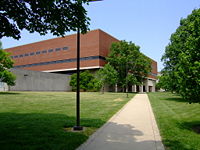
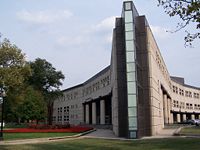
The Ohio State University comprises the following colleges and schools:
- Ohio State University College of Dentistry
- College of Education and Human Ecology
- College of Engineering
- Austin E. Knowlton School of Architecture
- College of Food, Agricultural, and Environmental Sciences
- School of Environment and Natural Resources
- College of Medicine
- College of Nursing
- College of Optometry
- College of Pharmacy
- College of Public Health
- College of Social Work
- College of Veterinary Medicine
- Colleges of the Arts and Sciences
- School of Communication
- School of Music
- Graduate School
- John Glenn School of Public Affairs
- Max M. Fisher College of Business
- Michael E. Moritz College of Law
The university also operates several regional campuses and research facilities at:
- "The Ohio State University, Agricultural Technical Institute"
- "Ohio State University, Lima Campus"
- "The Ohio State University, Mansfield Campus"
- "The Ohio State University, Marion Campus"
- "The Ohio State University, Newark Campus"
OSU also has several research facilities and centers located around the U.S.:
- "Byrd Polar Research Center"—Facility for Polar and Alpine research.
- "Biological Research Tower"—Facility designed to create and study new systems of personalized healthcare.
- "Large Binocular Telescope" (LBT, originally named the Columbus Project)—designed to be the world's highest resolution and most technologically advanced optical telescope[17]
- "Mershon Center for International Security Studies"
- "Stone Laboratory"—Facility shared by Great Lakes Aquatic Ecosystem Research Consortium.
- "Ohio Agricultural Research and Development Center"—Devoted to the research of foods, agriculture, family, and the environment.
Student life
OSU offers its large student population an environment rich in experience and possibilities beyond education. Ohio State's main campus has been lauded for the diversity of its student body. In various surveys and rankings it has been included among the best campuses in the nation for African Americans,[18] as well as for Hispanics, and gays and lesbians.[19]
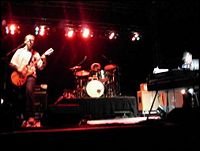
Student organizations at OSU provide students with opportunities in a wide variety of interest areas including academic, social, religious, artistic, service-based, diversity and many more. There are over 800 registered student organizations that involve many thousands of students.
There are three recognized student governments that represent their constituents.
- Undergraduate Student Government (USG), which consists of elected and appointed student representatives who serve as liaisons from the undergraduate student body to university officials.
- Council of Graduate Students (CGS), which promotes and provides academic, administrative, and social programs for the university community in general and for graduate students in particular.
- Inter-Professional Council (IPC), which is a representative body of all professional students in the colleges of Dentistry, Law, Medicine, Optometry, Pharmacy, and Veterinary Medicine.
Ohio State has several student managed publications and media outlets: The Makio is the official yearbook and is operated by students, for students. The Makio was started by three fraternities in 1880. The Lantern is the school's daily newspaper and has operated as a laboratory newspaper in the School of Communication (formerly the School of Journalism) since 1881. Mosaic is a literary magazine published by Ohio State, which features undergraduate fiction, poetry, and art. OHIO.FM is the student-run radio station with an Internet audio stream (no broadcast signals are available in Columbus). Students also operate a local cable channel known as Buckeye TV, which airs primarily on the campus cable system operated by the Office of Information Technology (OIT).
Ohio State's intercollegiate sports teams are called the "Buckeyes" (after the state tree, the Buckeye), and participate in the NCAA's Division I in all sports (Division I FBS in football) and the Big Ten Conference in most sports. The school colors are Scarlet and Gray. "Brutus" the Buckeye is their mascot. Ohio State teams have won national championships in baseball, men's basketball, football, men's swimming and diving, men's outdoor track and field, men's golf, men's gymnastics, men's fencing, co-ed fencing, and multiple synchronized swimming championships.[20]
Traditions
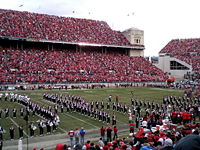
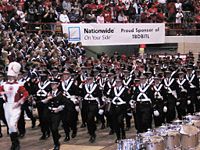
The Ohio State University Marching Band (or TBDBITL, "The Best Damn Band in the Land") is a longstanding tradition at Ohio State. This marching band is one of the largest all-brass and percussion bands in the world. Traditional school songs, from Carmen Ohio to Hang on Sloopy to Fight the Team Across the Field, are arranged to fit this unique instrumentation. The band is famous for Script Ohio, during which the band marches single-file through the curves of the word "Ohio," much like a pen writes the word, all the while playing the French march Le Regiment de Sambre et Meuse. At the end of the performance, the "i" in "Ohio" is "dotted" by a high-stepping senior sousaphone player.[21] On occasion a non-band member has been selected for the honor of dotting the "i." This is considered the greatest honor the band can bestow to any non-band member and is an extremely special (and rare) event. Jack Nicklaus had this privilege at the Ohio State homecoming game on October 28, 2006, when the Buckeyes played Minnesota.[22]
Every year OSU hosts the Denman Forum, in which undergraduate students are invited to showcase research they have done in a specific topic to both the public and to a panel of judges who award distinctions upon the best projects. The forum is meant to inspire undergraduate students to maintain the strong tradition of scholarly research, by both students and faculty, that distinguishes OSU.[23]
A longstanding tradition at OSU is the belief that rubbing the nose of the statue of William Oxley Thompson in the main library will bring a student luck on tests, particularly for final exams.[24]
Notable alumni
Ohio State alumni include Nobel Prize, Pulitzer Prize, and Medal of Honor recipients, ambassadors, as well as Fortune 500 CEOs and members of the Forbes 400 list of the world's wealthiest individuals. Numerous graduates have gone on to become Governors, Senators, and members of Congress. Ohio State alumni have appeared on the cover of TIME twelve times, with the artwork of alumnus Roy Lichtenstein featured on an additional two TIME covers.
Ohio State alumni are enshrined in the Baseball Hall of Fame in Cooperstown, New York, the NFL Hall of Fame, and the Basketball Hall of Fame. Its athletes have won a combined eighty-three Olympic medals and three times received the Sullivan Award as the nation's top amateur athlete. Jack Nicklaus, has often been called "the greatest golfer in history" while Jesse Owens, has often been called "the greatest Olympian in history." Twice, Ohio State alumni have graced the cover of Sports Illustrated as its Sportsman of the Year.
- Homer Burton Adkins—organic chemist who developed the Adkins catalyst.
- Daniel G. Amstutz—U.S. government official and grain-trading industry executive who played a prominent role in the negotiation of the Uruguay Round General Agreement on Tariffs and Trade (GATT) rules on agriculture and the U.S. occupation of Iraq.
- Miller Anderson—Diving 1948 Summer Olympics Silver Medal; 1952 Helsinki Olympic Games Silver Medal.
- William “Mil” Batten—former CEO of J. C. Penney (1958–1974), former President of The New York Stock Exchange (1976–1984).
- John W. Bricker—three-term Governor of Ohio, Republican Vice-Presidential nominee in 1944, Two-term United States Senator from Ohio, Co-founder of Bricker & Eckler law firm, known for the Bricker Amendment, which limits U.S. presidents to two consecutive terms of office.
- Jesse L. Brown—First African American Navy pilot, received Navy Distinguished Flying Cross.
- Paul Brown—famous coach, member of the Pro Football Hall of Fame, and namesake of Paul Brown Stadium.
- Milton Arthur Paul Caniff—a American cartoonist famous for the Terry and the Pirates and Steve Canyon comic strips.
- Agnes Meyer Driscoll—cryptanalyst deciphered Japanese Naval Codes before and during World War II.
- Ruby Elzy—a pioneer African American operatic soprano who created the role of Serena in George Gershwin's folk opera Porgy and Bess and performed in it more than eight hundred times.
- Max Martin Fisher—an internationally-known businessman, philanthropist, and benefactor/alumnus of the Fisher College of Business at Ohio State University.
- Paul Flory—1974 Nobel laureate in Chemistry.
- William A. Fowler—1983 Nobel laureate in Physics.
- Les Horvath—Heisman Trophy winner 1943.
- Kermit Houston Hunter—playwright known primarily for writing outdoor historical dramas.
- Charles Kettering—Electrical Engineer, Founder of "Delphi Auto Parts," Vice-President of Research for General Motors, invented electric starter for automobiles, Co-founder (along with Alfred Sloan) of Sloan-Kettering Cancer Center in 1945.
- David Kier—Historian and author of fantasy novels
- Curtis LeMay—United States Air Force general (World War II and Cold War).
- Ruth Ella Moore—first African American woman to receive a doctorate degree in Bacteriology.
- Jack Nicklaus—also known as "The Golden Bear," professional golfer, winner of 18 professional majors in a PGA Tour career lasting 25 years, from 1962 to 1986, and eight of the Champions Tour, the senior version of the PGA Tour, majors between 1990 and 1996.
- Jesse Owens—Track and Field 1936 Berlin Olympic Games Four Gold Medals.
- Arthur M. Schlesinger, Sr.—noted historian; Harvard's Schlesinger Library in women's history is named after him and his wife Elizabeth, a noted feminist.
- James Thurber—author and humorist.
- Roberto Sánchez Vilella—second Governor of the Commonwealth of Puerto Rico.
- Malden Whitfield—Track and Field 1948 London Olympic Games Two Gold Medals, Bronze Medal; 1952 Helsinki Olympic Games Gold Medal; Silver Medal.
Notes
- ↑ 1.0 1.1 Academic Plan, "The Ohio State University Vision," Ohio State University, 2008. Retrieved December 9, 2008.
- ↑ John Lombardi, Elizabeth Capadli, and Craig Abbey, The Top Ten American Research Universities: 2007 Annual Report, The Center for Measuring University Performance, 2007. Retrieved December 9, 2008.
- ↑ Amy Murray, "Ohio State news release on 2007 rankings," Ohio State University, August 17, 2007. Retrieved December 9, 2008.
- ↑ Best Colleges, Ohio State University—Columbus, U.S. News & World Report, 2008. Retrieved December 9, 2008.
- ↑ Dayton Business Journal, Ohio State named nation’s largest college—again, American City Business Journals, Inc., October 20, 2008. Retrieved December 23, 2008.
- ↑ The Ohio State University, Access to Education. Retrieved December 28, 2008.
- ↑ Ari Arthur Hoogenboom, The Presidency of Rutherford B. Hayes (University Press of Kansas, 1988, ISBN 0700603387), 10.
- ↑ Ophia D. Smith, James E. Campbell 1890-1892, The Ohio Historical Society, 2005. Retrieved January 7, 2009.
- ↑ H. H. Daugherty, Harry L. Davis 1921-1923, Ohio Historical Society, 2005.
- ↑ Kevin P. Bower, "'A favored child of the state:' Federal Student Aid at Ohio Colleges and Universities, 1934-1943," History of Education Quarterly 44(3) (2004): 364-387.
- ↑ National Association of College and University Business Officers, 2005 NACUBO Endowment Study, NACUBO, 2006. Retrieved December 19, 2008.
- ↑ Wexner Center for the Arts, About Us, The Ohio State University, 2008. Retrieved December 11, 2008.
- ↑ Ohio State University, Visitors: Gardens and Plazas, Ohio State University, 2008. Retrieved December 11, 2008.
- ↑ Ohio State University, About The Ohio State University Libraries. Retrieved December 11, 2008.
- ↑ Ohio State Football, Ohio Stadium, Ohio State University, 2008. Retrieved December 13, 2008.
- ↑ Fisher College of Business, Student Investment Management (SIM), Ohio State University, 2008. Retrieved December 19, 2008.
- ↑ Large Binocular Telescope Observatory, Welcome, Large Binocular Telescope Corporation, 2008. Retrieved December 13, 2008.
- ↑ Sonya A. Donaldson, "50 Best colleges for African Americans: The right college environment can make or break an experience. Here's how to make sure students choose the school that's best for them. (Special Report)," Black Enterprise, January 1, 2003. Retrieved December 13, 2008.
- ↑ Stephanie Rosenbloom, "Is This Campus Gay-Friendly?" The New York Times, September 14, 2006. Retrieved December 13, 2008.
- ↑ NCAA Championships, NCAA National Championship Database, NCAA Championships, 2007. Retrieved December 13, 2008.
- ↑ The Ohio State University Marching and Athletic Bands, History of the Ohio State Marching Band, Ohio State University Marching Band, 2006. Retrieved December 19, 2008.
- ↑ Associated Press, Strike up the band: Nicklaus dots 'i' at Ohio State, College Football, ESPN, October 28, 2006. Retrieved December 19, 2008.
- ↑ Do Something Great, "Discoverers," Ohio State University, May 20, 2008. Retrieved December 19, 2008.
- ↑ Roland Becerra and Adam Jardy, Ohio State University 2007 (College Prowler, 2006. ISBN 1427401071).
References
ISBN links support NWE through referral fees
- Baroway, Malcolm S. The Gee Years, 1990-1997. Columbus, OH: Ohio State University Press, 2003. ISBN 0814209181.
- Becerra, Roland, and Adam Jardy. Ohio State University 2007. College Prowler, 2006. ISBN 1427401071.
- Herrick, John H. The Ohio State University Oval. Office of Campus Planning and Space Utilization, Columbus, OH: The Ohio State University, 1982. Retrieved January 7, 2009.
- Herrick, John H. The Ohio State University Mirror Lake Hollow. Office of Campus Planning and Space Utilization, Columbus, OH: The Ohio State University, 1984. Retrieved January 7, 2009.
- Hoogenboom, Ari Arthur. The Presidency of Rutherford B. Hayes. University Press of Kansas, 1988. ISBN 0700603387.
- Kinnison, William A. Building Sullivant's Pyramid; An Administrative History of The Ohio State University, 1870-1907. Columbus, OH: Ohio State University Press, 1970. ISBN 0814201415.
- Perry, Chris. The Kirwan Years: 1998-2002. Columbus, OH: Ohio State University Press, 2005. ISBN 0814210279.
External links
All links retrieved November 17, 2022.
- The Ohio State University Official website
- The Ohio State University Official Athletics website
- The Ohio State University Oral History Project
| Association of American Universities | |
|---|---|
| Public |
Arizona • Buffalo (SUNY) • UC Berkeley • UC Davis • UC Irvine • UCLA • UC San Diego • UC Santa Barbara • Colorado • Florida • Illinois • Indiana • Iowa • Iowa State • Kansas • Maryland • Michigan • Michigan State • Minnesota • Missouri • Nebraska • North Carolina • Ohio State • Oregon • Penn State • Pittsburgh • Purdue • Rutgers • Stony Brook (SUNY) • Texas • Texas A&M • Virginia • Washington • Wisconsin |
| Private |
Brandeis • Brown • Caltech • Carnegie Mellon • Case Western Reserve • Chicago • Columbia • Cornell • Duke • Emory • Harvard • Johns Hopkins • MIT • Northwestern • NYU • Penn • Princeton • Rice • Rochester • USC • Stanford • Syracuse • Tulane • Vanderbilt • Washington • Yale |
| Canadian |
McGill • Toronto |
Credits
New World Encyclopedia writers and editors rewrote and completed the Wikipedia article in accordance with New World Encyclopedia standards. This article abides by terms of the Creative Commons CC-by-sa 3.0 License (CC-by-sa), which may be used and disseminated with proper attribution. Credit is due under the terms of this license that can reference both the New World Encyclopedia contributors and the selfless volunteer contributors of the Wikimedia Foundation. To cite this article click here for a list of acceptable citing formats.The history of earlier contributions by wikipedians is accessible to researchers here:
- Ohio_State_University history
- History_of_the_Ohio_State_University history
The history of this article since it was imported to New World Encyclopedia:
- History of "Ohio State University"
Note: Some restrictions may apply to use of individual images which are separately licensed.
↧ Download as ZWI file | Last modified: 02/04/2023 00:32:06 | 33 views
☰ Source: https://www.newworldencyclopedia.org/entry/Ohio_State_University | License: CC BY-SA 3.0
 ZWI signed:
ZWI signed: KSF
KSF